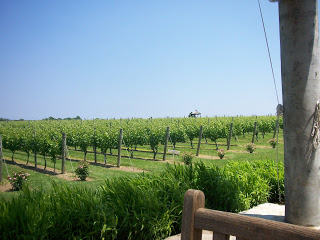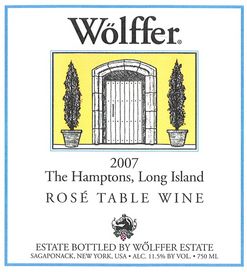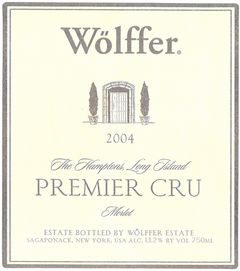
Wolffer Estates: Sustainable Wine on Long Island
 This week my husband wanted to take a crack a writing. It is a subject that he is very fond of so I have taken the editor role and he is the writer. Hope you all enjoy.
This week my husband wanted to take a crack a writing. It is a subject that he is very fond of so I have taken the editor role and he is the writer. Hope you all enjoy.
Ok, I love wine. There I said it. I love it, and have a glass just about every night of the week — partially because one or two glasses of red is good for lowering my cholesterol, and partially because I just love the taste and the warm feeling of it in my belly. I don’t know all that much about wine, but know what I like and what I don’t.
I was really excited when Melissa told me that we had been invited to Wolffer Estates in Sagaponack, NY (The Hamptons) for a private tour and interview with the head winemaker and general manager, Roman Roth. Long Island wines have had a pretty spotty reputation, but a few vineyards are known for a consistent and quality product, and Wolffer is one of them. So needless to say I was psyched; I’d get to taste some really nice wines, and talk with someone who is VERY knowledgeable about winemaking.
Until now, I thought my nightly wine drinking necessitated me breaking my environmental vows. But I discovered from our visit to Wolffer, the vineyard is not only known for their reputation for good wine but for their sustainable wine growing/making practices.
 Wine making on Long Island has a relatively short history. On Long Island alone there are more than 43 vineyards (according to the Long Island Wine Council). These winemakers cover nearly 3,000 acres and produce upwards of 4,000 tons of grapes a year. So for a small area, Long Island produces a lot of wine, employs a lot of people, and generates a lot of revenue. Wolffer has two vineyards; one covering 50 acres (which we visited) and another 20 planted on the North Fork of the island. They produce around 15,000 cases of wine a year, and isn’t the most sustainable vineyard on Long Island, (there are 7 others), but it’s among the most vocal in touting its practices.
Wine making on Long Island has a relatively short history. On Long Island alone there are more than 43 vineyards (according to the Long Island Wine Council). These winemakers cover nearly 3,000 acres and produce upwards of 4,000 tons of grapes a year. So for a small area, Long Island produces a lot of wine, employs a lot of people, and generates a lot of revenue. Wolffer has two vineyards; one covering 50 acres (which we visited) and another 20 planted on the North Fork of the island. They produce around 15,000 cases of wine a year, and isn’t the most sustainable vineyard on Long Island, (there are 7 others), but it’s among the most vocal in touting its practices.
Before I get to the wine, let me take a moment to explain what sustainable growing practices are or “Sustainable Agriculture”. According to the University of California, Davis:
Sustainable agriculture integrates three main goals–environmental health, economic profitability, and social and economic equity. Sustainability rests on the principle that we must meet the needs of the present without compromising the ability of future generations to meet their own needs. Therefore, stewardship of both natural and human resources is of prime importance. Stewardship of human resources includes consideration of social responsibilities such as working and living conditions of laborers, the needs of rural communities, and consumer health and safety both in the present and the future. Stewardship of land and natural resources involves maintaining or enhancing this vital resource base for the long term.”
While the definition of sustainable agriculture is constant, the method varies from region to region, reflecting differences in soil and crop, climate and management styles. For the grape growers of New York State, it’s a process by which growers choose practices that are environmentally responsible while still maintaining the economic viability of the business. Some methods include efficient use of equipment, maintaining soil health and vine nutrition and managing vines for improved pest control.
Roman told us that Wolffer had not used any insecticides in eight years. This was both due to the fact that there hadn’t been any major outbreaks of bugs in the region and that the vineyard has made a decision to farm sustainably. Pests can kill a crop. Fungus can destroy both a crop and the vines themselves. To protect against fungus, Wolffer doesn’t use industrial fungicides, rather Roman sprays his vines with Stylet-Oil. “Stylet-Oil is a food grade, high purity mineral oil. It has had impurities removed through additional distillation steps involving high pressure and steam, leaving a tech white mineral oil-similar to Johnson’s Baby Oil. Additional ingredients include emulsifying materials blended into the oil allowing it to mix with water,” according to Jeff Symons President of JMS Flower Farms (makers of Stylet-Oil).
While walking between the rows of Chardonnay grapes, Roman showed us the way the vines had been planted. Amazingly Wolffer had been designed to focus not on increasing yield, but rather increasing the viability of the overall vineyard. Every other season, Wolffer field-hands plant mustard and clover plants in between ever other row of vines to help mitigate pests. There are four acres of wildflowers planted to encourage bees to visit the vineyard to assist in pollination.
Well over the course of an hour talking with Roman we discussed Wolffer’s commitment to sustainable farming while sipping some truly nice and memorable wines.

We started off with the Wolffer Rosé from 2007. As we sat outside, on their covered patio, overlooking the vineyard, Melissa and I were treated to a very nice, crisp Rosé with just enough fruit to keep it honest. Neither of us expected to like this refreshing wine, as we both tend to like full-bodied reds to blended, chilled whites. But, it was hot, it had taken us nearly 2 hours (in Hamptons traffic) to get to Wolffer and this Rosé really took the bite off the heat.
I asked Roman if Wolffer had chosen to farm sustainably for economic or marketing reasons. Roman stated quickly that for Wollfer “…this is a decision made from a healthy vineyard perspective. This is the right approach to keeping a healthy vineyard, to keeping it alive with its own bio dynamic.” Roman explained that while it might cost a bit more to farm in this fashion, with a tunnel sprayer to collect the drippings from any sprayed fertilizer or stylet oil to keep fungus outbreaks down, that long-term it made better economic and environmental sense for Wolffer.
As Roman poured us our second glass of wine, a sparkling Brut Cuvee from 2004, the talk turned to whether or not Wolffer was an organic vineyard. Turns out it is not, but this might not be such a bad thing according to Roman, “By keeping very neat rows and open canopies we have less fungus pressure. We are not organic, but we try to do as much as possible. You have to work your way towards organic and sustainable farming. You can’t just do it overnight…well you can, but you’ll make horrible wine, and that’s not in anyone’s best interest.”
In this instance the proof of this fact was in the tasting. This champagne-style wine was excellent – sharp, but not bitter, crisp with a bit of apple taste to it, and very drinkable. Continuing on the discussion of Wolffer’s organic goals, Roman told us it was a possibility but not a guarantee.

After a walk through the rows of vines we went back to the patio for our final glass of wine of the afternoon, a truly impressive Merlot from 2004. Now this was more to our tastes. The wine was bold for a Merlot, with a strong flavor of berries and a smoky, coffee flavor. As the final taste of the afternoon, we settled in to enjoy the sun, the view (Wolffer’s tasting room/patio is one of the most beautiful I’ve been in) and finish our conversation about the value of sustainable viticulture. Roth summarized the entire sustainable winemaking philosophy perfectly, “You have you to be a steward for all of this (the environment), this has to last for hundreds of years, and this sustainable movement is helping us both today, and tomorrow.”
If you are every in the Hamptons, I suggest stopping at Wollfer Estates tasting room. Sit on the patio looking at the beautiful vineyard while drinking some really good wine that has been produced in manner that is not only good for you but the environment.





